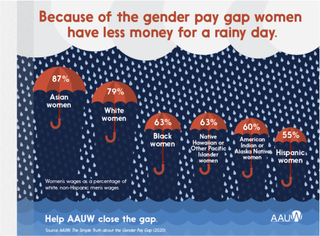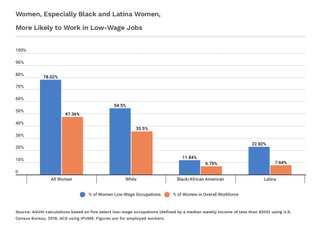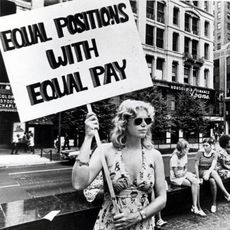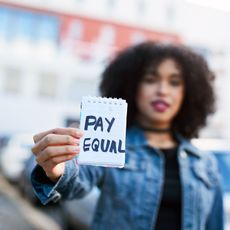Confronting Unequal Pay: A 10-Step Guide for Women—and Their Allies—to Fight Wage Discrimination
Black Women’s Equal Pay Day is not a celebration. My hope is that if we all continue to ask for what we want, we chip away at that wage gap, one Black woman—and ally—at a time.


This year, Black Women’s Equal Pay day falls on Wednesday, September 21, and that means that Black women must work an extra 264 to earn what a white, non-Hispanic man had by December 2021. Black Women’s Equal Pay Day is not a celebration! No woman should be celebrating these pay inequities—but we should continue to sound the alarms until we achieve pay equity. Not just for Black women, but for any woman who is being undervalued.
I am a Black woman, and as an entrepreneur and author, there are times that I still experience pay inequality if I don’t advocate for myself. Because we all have a voice, we just have to decide how we are going to use it.
Recently, I was booked for a speaking engagement. The speech that I was supposed to give was originally in person, but it was shifted to a virtual event. When we agreed that I would come speak they had a budget to pay me $10,000 dollars. Once they made the decision to go online, they said their budget had significantly changed and they could now only pay me $2,000.
Math has not always been my strong suit, but this math was not adding up! They were still asking me to perform the same job, regardless of the format of the event. I remembered that someone I knew casually (let’s call her Jenny) had recently spoken there and that she’d done her talk online. Something inside me pushed me to reach out to her and ask about her experience and fee.
My curiosity about whether I was being compensated fairly was larger than my fear of the uncomfortable conversation. Because if I didn’t get more information, I would always be wondering if that organization tried to play me. I mean, come on, my life’s work is to make the workplace better for all women of color, and that includes myself!

Why Equal Pay Matters: Since 80 percent of Black mothers are the sole, co-breadwinners, or primary breadwinners for their households, a fair salary can mean the difference between struggling and sustainability for a family, according to the AAUW.
I took the leap and reached out to Jenny. I told her that I would be speaking at the same company and that I suspected they were paying me less than other speakers. I said to her, “I hate to put you in this position, but would you feel comfortable telling me what they offered you?”
Jenny was very cool about it. She told me that they were paying her nearly my originally stated amount (of $10,000) and they were buying her book in bulk for the attendees. This new information left me disappointed in the organization, of course, but also happy that I’d done my research. I then had to decide if I was going to have another tough conversation—this time with the organizers of the event.
Stay In The Know
Get exclusive access to fashion and beauty trends, hot-off-the-press celebrity news, and more.
After I gathered all the facts, I sat and thought about what I wanted to say to the organizers. I knew that I couldn’t out Jenny as my informant. She was beyond kind to be honest with me, and I didn’t want her decision to affect her relationship with the organization.
Here's how I handled the situation, which I hope can be a map for all women to have similar conversations.
Phase I: Choose to Take a Conscious Approach
In my case, before taking any action, I thought about three things: emotion, perception, and openness. These first three steps are essential because 80 percent of facing a tough situation is about readying yourself mentally and emotionally.
1. Emotion. Yes, you do have to manage emotions from the start. This company was choosing to pay me, a Black woman, less than what they were offering to a white woman to do the same type of work. I had every right to be upset. At first, I wanted to say, forget it, I don’t want to do the speaking engagement at all. But if I handled this situation the wrong way and jumped to conclusions, news of my reaction might get out to future potential clients. And when you are considering having a tough conversation, you must consider all the possible outcomes.
2. Perception. Next, I asked myself: How was I interpreting this situation? My initial perception was that they were trying to cheat me. But then I told myself to think about it some more. Could there be some other reason why they didn’t offer me what they offered Jenny? Maybe they were trying to cheat me, but maybe they weren’t. I can’t and won’t make excuses for them, but I had to allow myself to look at the various perspectives, not just my own.
3. Openness. If I was going to confront this wage gap, then I had to be open to hearing what the organizers had to say. That’s part of the reason I needed to sit with my emotions: The only way to get to an open mindset is to first process my feelings. I had to decide even before I initiated this conversation that I would be willing to be open and hear their full story. It would not serve me at all to just say what I had to say and then end the conversation.
I won’t make up a fantasy that everyone will smile and listen, and no emotions will flare up, but, as people, we can be open to hearing from one another.

There’s an even bigger pay gap in the service industry, where women make less per week than women working full-time across all occupations. That’s why a livable minimum wage is crucial to all women (who make up two-thirds of tipped workers), and especially Black women.
Phase II: Take Action.
I know you’re probably thinking, Come on, Minda, what ended up happening? I have to tell you, this was one of the hardest conversations I’ve had in a long time.
We can’t always control what someone says or does when we ask for what we want, but the ask is part of the equation that we do control—and it’s necessary if we want to break this inequitable pay structure.
Here are seven additional action steps that helped me navigate the actual conversation. The seven steps happen to spell out Beyoncé as an acronym, which is meaningful for more reasons than one. But amp-up playlist aside, following this framework is critical for combating pay discrimination in the most professional way.
1. Bet on yourself. Having tough conversations with people from your parents to crushes to your first manager is never easy, and it might seem easier to just avoid these situations altogether. But it isn’t healthy to throw the covers over your head and pretend that issues will go away just because you choose not to confront them. In this case, I was nervous to reach back out to the organizers, but I knew I deserved to understand why I was being paid less than another woman. And I needed to bet on myself because self-advocacy is part of loving yourself. I made a choice and chose me.
2. Encourage yourself. Even as the little voice inside my head was trying to persuade me to just leave it alone, I thought about my purpose and why I started my company, The Memo, LLC, in the first place. My goal was to help create more equality for women and girls that look like us. If I took this speaking opportunity for less than I was worth, I could be helping to widen the wage gap. Advocating for myself was advocating for all Black and brown women, who deserve to be paid fairly. I ended up playing my favorite Beyoncé song (“Freedom for Girls,” “Grown Woman,” and, of course, “Who Run the World?” are all great tracks for motivation) and forged ahead by reminding myself that I am worth it and so are you.
3. You have the information. This is one of the most important B.E.Y.O.N.C.E. steps. When you’re considering having a tough conversation, gather your receipts first. Don’t just start popping off about your point of view without having all of the details. In order to have a stronger case, I needed evidence that would support my stance; Jenny was able to help fill in those gaps with new information.
4. Onward. This is also important: If you feel strongly about having this conversation, don’t talk yourself out of it. I will be honest with you and say that at this stage, I definitely was thinking about just letting it go, but I decided to move forward due to my values, principles, and boundaries.
5. Navigate your emotions. I also knew that I needed to handle this situation professionally, because this organization was heavily connected to potential clients that might hire me in the future. If I chose to act accusatory or temperamental, then that wouldn’t help us get to a resolution. I wanted to remain professional at every step of the discussion.
6. Concrete facts. You already have the information, now you need to stick to those facts during the conversation. I had to remember when speaking with this company that I wanted to be able to come to a resolution, or at least an understanding. And that meant that I couldn’t make assumptions or point fingers. I needed to keep my conversation rooted in what I knew my truth to be. And that truth was that I could not, in good faith, talk about how to make the workplace better for women of color and not be compensated fairly. If they were able to offer a fair price, I would love to work together. I gave them my facts and then gave them the opportunity to present their truths and facts as well.
7. End it. We can only control what is within our control. I was able to control whether or not I would have this conversation. And, after having it, I couldn’t go back and forth in my mind about the possible outcomes. I had to own it, end it, and hope for the best. Ending it means letting go once the conversation wraps up. Regardless of the outcome, you did it! In this case, I felt so much better after advocating for myself and the future women of color they hire.
In this case, the outcome was positive. I told the organizers how I was feeling about the new fee they proposed. I said that I was concerned that they were asking me to do the same work that they originally offered me $10,000 for, but with a heavily decreased rate of $2000. I let them know that, after speaking with others who had worked with them (not mentioning Jenny by name!), I had learned that what they were offering me wasn’t aligned with their usual rates. I reminded them that I was a bestselling author, and that my book, The Memo: What Women of Color Need to Know to Secure a Seat at the Table, addresses these exact issues. I told them that I would be very happy to speak to their organization, but that they would need to pay me the $10,000 fee we’d originally agreed to.
And they said yes!
Look at that! What if I never had that conversation? Yes, I agonized over it. It’s a struggle every time I have to have a tough conversation, and sometimes they don’t go my way. But advocating for myself worked out this time. My hope is that if we all continue to ask for what we want, we will chip away at that wage gap, one Black woman—and ally—at a time.

Minda Harts is a Workplace and Equity Consultant. She is also the bestselling and award-winning author of The Memo and Right Within. Her third book, You Are More Than Magic for Young Adults, was released in April 2022. Minda is a Professor at NYU Wagner.
-
 Katie Holmes Tames an Underrated Animal Print Trend
Katie Holmes Tames an Underrated Animal Print TrendTiger is the new leopard.
By Kelsey Stiegman Published
-
 Taylor Swift's Beloved Red Lipstick Is Finally Back in Stock
Taylor Swift's Beloved Red Lipstick Is Finally Back in StockIt's been a long time coming.
By Halie LeSavage Published
-
 I Move Up a Tax Bracket Every Time I Wear This Opulent Manicure
I Move Up a Tax Bracket Every Time I Wear This Opulent ManicureBonus: you can achieve the look with $15 press-on nails.
By Samantha Holender Published
-
 Give Mom What She Really Wants This Year: Equal Pay
Give Mom What She Really Wants This Year: Equal PayMoms have faced some of the biggest setbacks since the pandemic started. So this year, don’t just say it with flowers—say it with phone calls to your Senators and your HR department.
By Elizabeth Barajas-Román Published
-
 What Equal Pay Day Gets Wrong
What Equal Pay Day Gets WrongThe day marks how far into the year an average woman must work to earn what the average man earned the year prior. In her first finance column for Marie Claire, Sallie Krawcheck shares why Equal Pay Day also isn't measuring up.
By Sallie Krawcheck Published
-
 Today, Black Women’s Equal Pay Day, Illustrates Just How Much Black Women Are Undervalued and Underpaid
Today, Black Women’s Equal Pay Day, Illustrates Just How Much Black Women Are Undervalued and UnderpaidIn addition to the wage gap, new research from LeanIn.org shows that there are numerous "invisible" injustices as well.
By Megan DiTrolio Published
-
 America Deserves to Be Shamed by the U.S. Women's Soccer Team
America Deserves to Be Shamed by the U.S. Women's Soccer TeamWhat more do the four-time World Cup champions have to prove to get equal pay?
By Cady Drell Published
-
 Rejoice: You'll Get 20 Percent Off at These Retailers on Equal Pay Day
Rejoice: You'll Get 20 Percent Off at These Retailers on Equal Pay DayI guess it's something?
By Megan Friedman Published
-
 Audi's Super Bowl Ad Calls for Equal Pay—And a Lot of People Aren't Happy About That
Audi's Super Bowl Ad Calls for Equal Pay—And a Lot of People Aren't Happy About ThatSeriously? In 2017?
By Megan Friedman Published
-
 Why Female Doctors Are Paid So Much Less Than Their Male Counterparts
Why Female Doctors Are Paid So Much Less Than Their Male CounterpartsWe're talking a difference of $15,000. (Yeah...)
By Megan Friedman Published
-
 Women CEOs Experience Less Pay Gap
Women CEOs Experience Less Pay GapBut the climb to the top isn't so easy.
By Laura Cohen Published